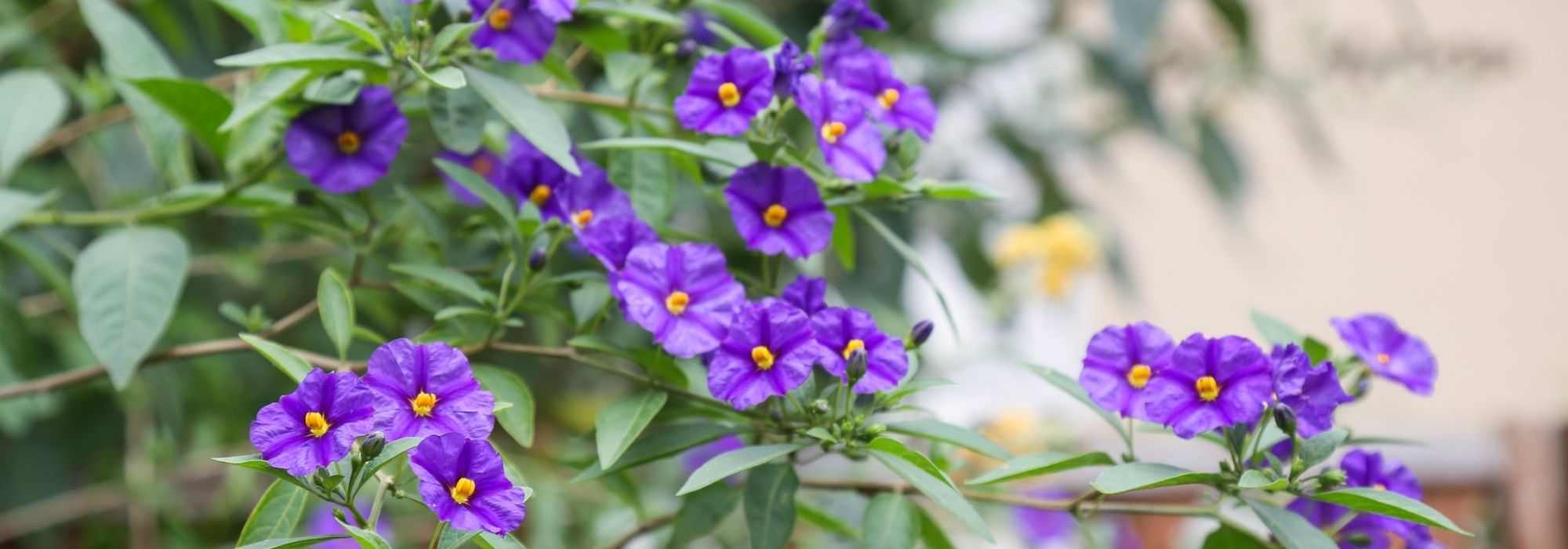
7 ideas to pair Solanum in the garden
Create 7 beautiful scented scenes around solanum
Contents
Solanums are plants native to southern Brazil and Paraguay. They are widely used in gardens across southern Europe to adorn walls. The Solanum rantonetti, or tree gentian, is a bush with soft green evergreen foliage that produces beautiful purple flowers at the end of summer. If you live in the south, you can enjoy all the solanums; elsewhere, you can grow them in pots on your terrace or balcony. Discover our seven ideas for combinations with solanum to create beautiful scented scenes.
To avoid any failures, we recommend planting appropriately; feel free to adopt our web application Plantfit.
To dress a wall
The Solanum jasminoides ‘Bleu’ is a slender, highly ramified liana whose young shoots turn a reddish-purple colour. This climbing plant with a subtly fragrant flowering should be placed near a sunny passage to enjoy it to the fullest. Its numerous bluish-white flowers add a delicate and luminous touch along a wall. Its dark green evergreen foliage reddens in cold weather. Create a surprising contrast with the golden-yellow foliage in spring of the golden hop Humulus lupulus ‘Aureus’, which turns chartreuse green in summer, while in winter the foliage of the solanum will persist and become marbled with red. To complete this generous ensemble, opt for the vigorous Japanese spiraea Spiraea japonica ‘Anthony Waterer’ for frost-free situations, with its abundant fuchsia pink flowering from July to September in flattened corymbs. Its deciduous red-bronze foliage in spring turns dark green in summer. Ideal plant for small gardens, in borders or pots. The Trachelospermum asiaticum, or Chinese jasmine, is an ideal climbing plant to flower and scent an entrance. Its voluble stems wrap around any support. In summer, star-shaped cream-white flowers appear, exuding a sweet jasmine fragrance. The Lonicera periclymenum ‘Serotina’ is a climbing honeysuckle with cream-white flowers striped with dark red and a powerful, very pleasant fragrance from July to September.
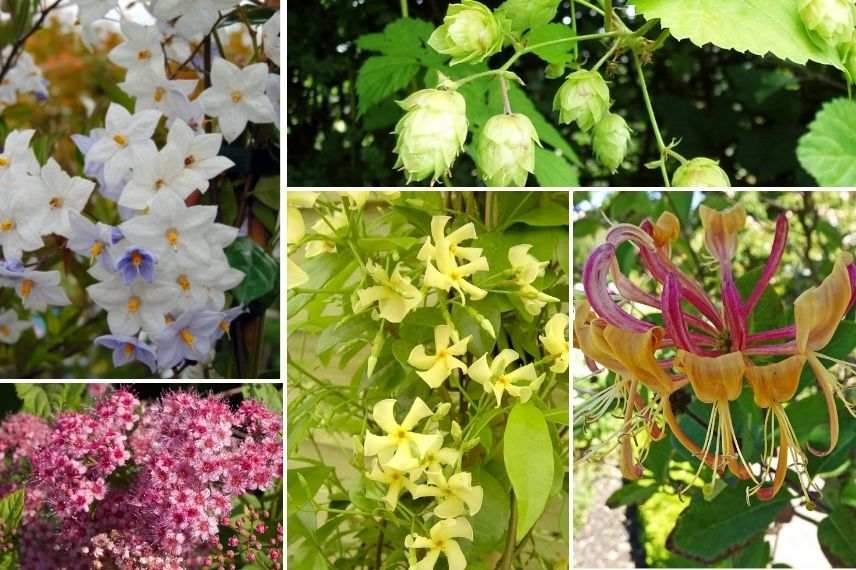
The tender blue stars of the solanum ‘Star of Bethlehem’ adorn the beautiful dark green evergreen foliage, contrasting with the deciduous foliage of the golden hop. An ideal setting for a blend of scents from the solanum, honeysuckle, and Chinese jasmine bordered by the Tyrian pink flowering of the famous Japanese spiraea ‘Anthony Waterer’.
To adorn a tree
With its climbing habit, the Solanum jasminoides ‘Blue’ will be the ideal host to awaken from its warm flowering an overlooked tree. Pair it with the Holboellia latifolia with large evergreen leaves. It can thus invest the crown of a tree with its small, highly fragrant bells resembling those of lily of the valley. It will need to be trained on a support in particularly windy situations. To dress a completely bare tree, rely on the vigour and abundant cream-white flowering in panicles of the Pileostegia viburnoides with its evergreen foliage, very similar to climbing hydrangeas. Your tree will then attract all the attention and the hungry if you plant at its feet a bush of Japanese Goumi Elaeagnus umbellata ‘Amoroso’. It stands out from afar, due to the silvery sheen of its ever-moving foliage. In autumn, covered in fruit, it is one of those that enlivens the garden. It is valuable in a seaside garden or a dry garden in windy regions.
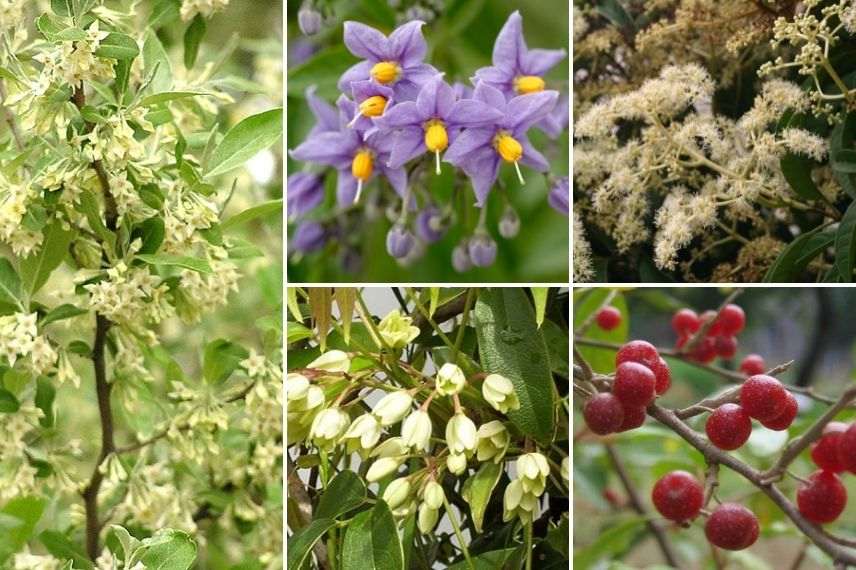
The Goumi bush Elaeagnus umbellata in flower on the left and in fruit on the right fills the air with fragrance in May. Meanwhile, Solanum crispum ‘Glasnevin’ and Holboellia in the centre of the photo, rise high above the evergreen foliage of the Pileostegia in bloom on the right.
Discover other Solanum
View all →Available in 0 sizes
Available in 1 sizes
Available in 1 sizes
Available in 1 sizes
Available in 1 sizes
Available in 1 sizes
To brighten up a wire fence in a flowering hedge
The Solanum jasminoides ‘Album’ has its place in a flowering hedge among common myrtle Myrtus communis subsp. Tarentina and the flamboyant Syringa ‘Red Pixie’. It is a weeping lilac with small leaves and fragrant pink repeat flowering. The creeping clematis Clematis recta ‘Purpurea’ with its purple foliage will highlight its small fragrant white flowers in this arrangement. When it appears in spring, its colour is not purple, but violet. Place at its feet the Thalictrum aquilegifolium with lovely foliage resembling an aquilegia. It develops fine stems bearing dozens of double lilac-pink flowers resembling gypsophila. This very decorative thalictrum adds a touch of romance to the garden.
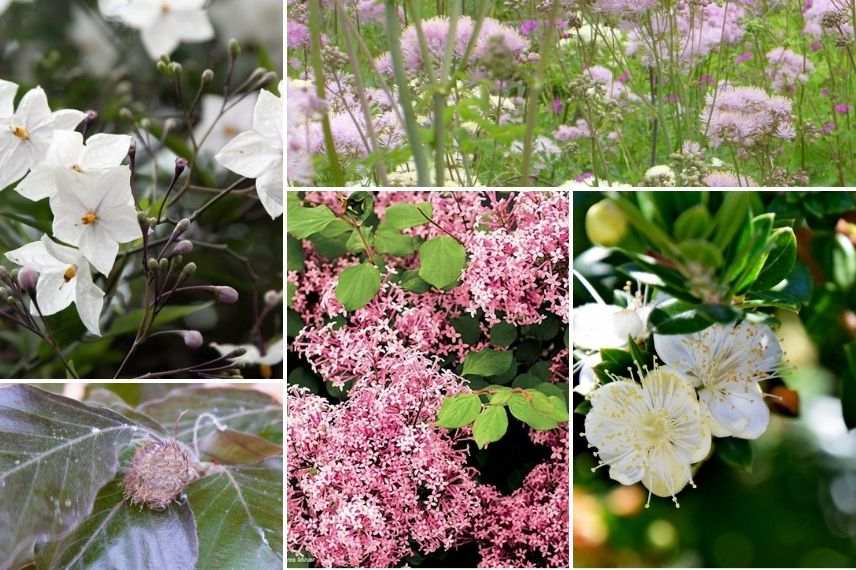
On the left, the white flowering of the Solanum jasminoides against the foliage of the purple clematis. At the bottom centre of the illustration, the ‘Red Pixie’ lilac with small leaves. To the right of the image, the white flowers of the ‘Tarentina’ myrtle bush. In the middle, the pink umbels of the Thalictrum with aquilegia-like leaves.
Read also
10 climbing plants ideal for fencesTo flower a pergola or trellis
The Solanum jasminoides ‘Album’ climbs to 4 to 6 m and can cover an entire pergola. Its jasmine-like white flowers turn into lovely purple berries at the end of the year, and the foliage takes on a red hue. Pair it with the beautiful clematis Clematis fargesii ‘Summersnow’. Its long stems easily climb the tallest supports, covering them with its lovely light green foliage. From July onwards, a multitude of small star-shaped white flowers appear, brightening this lovely mantle with freshness. Like most clematis, ‘Summersnow’ prefers light, deep, cool, and fertile soil. Don’t overlook the ease of growing the generous Banks rose ‘Lutea’ , a monumental and thornless liana. It blooms very early in spring, producing thousands of small double butter-yellow roses. ‘Lutea’ is undoubtedly the most vigorous of the Banks roses.
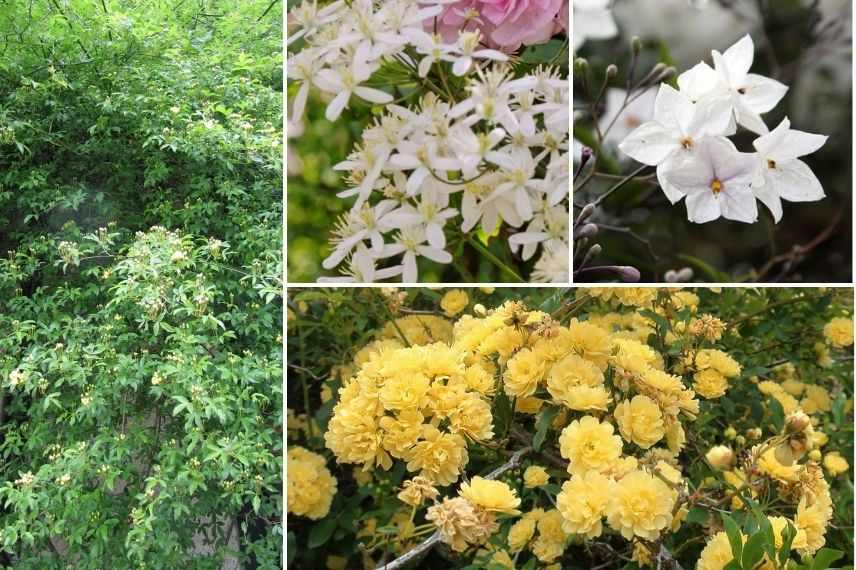
On the left, the vigorous Doctor Banks rose at the bottom, its sunny yellow bloom, and above, the flowers of the solanum and clematis ‘Summersnow’
To dress a staircase railing
Place a bush of Solanum rantonetti near your staircase, either in a pot or in the ground. It will flower until the frost, then the Sarcococca ruscifolia will take over with its fragrant flowering throughout winter. The clematis Clematis viticella purpurea ‘Plena Elegans’ will satisfy you with its double flowers, which are less fragile than those of its large-flowered cousins. The Plumbago auriculata will be trained on a trellis or fence to admire its cascade of sky-blue flowers mingled with the rose Rosa ‘Sourire d’Orchidée’. This rose produces beautiful clusters of pale, pearly dog roses, turning almost white at ripeness. Its flowers have an apple fragrance. It is ideal for an elegant and fragrant decor.

On the left, the voluble plumbago; in the centre, the Solanum rantonetti and the rose ‘Sourire d’Orchidée’, both fragrant; on the right, the purple-flowered clematis ‘Plena Elegans’ and the sarcococca, which scents the air in winter.
For a seaside garden
With the climbing solanum Solanum crispum ‘Glasnevin’, you will play with the lightness of the foliage, benefiting from the sea spray of your coastal location. Place it near a ceanothus Ceanothus arboreus ‘Trewithen Blue’ or a tamarisk Tamarix ramosissima ‘Rubra’ which will serve as support. Awaken this scene with the Solidaster luteus ‘Lemore’ and its dazzling flowering that lasts all summer, offering a multitude of small lemon-yellow stars, gathered in long cut flower arrangements above its narrow, bright green foliage. Surprise further with the Buddleia ‘Silver Anniversary’. This new variety of butterfly tree has a white summer flowering on tomentose silver-grey foliage. It withstands temperatures down to around -7 °C.
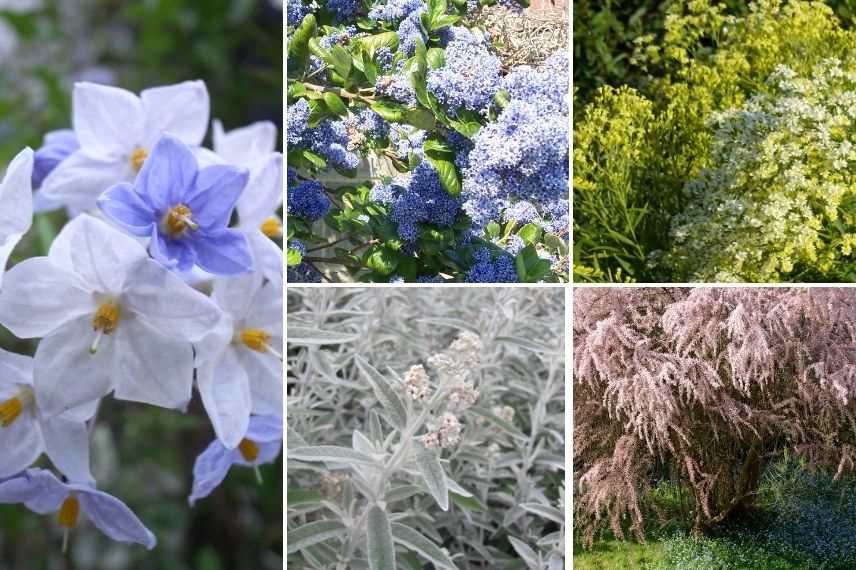
The bluish-white slender solanum on the grey ash foliage of Buddleia ‘Silver Anniversary’ in harmony with Ceanothus ‘Trewithen’ and the graphic elements of the tamarisk and Solidaster luteus on the right.
For an exotic decor
For an exotic decor on a veranda or balcony in a prime location, consider welcoming climbing solanum. These plants thrive in mild climates and can be easily grown in open ground in the south and along the Atlantic coast of our country. Elsewhere, they can be kept in a large pot and stored indoors during winter. Pair them with the vigorous climbing clematis Clematis tangutica ‘Lambton Park’, which offers a generous and prolonged flowering of pendulous yellow bell-shaped flowers from July to September, with a delightful coconut scent. The Rhodochiton atrosanguineus is another lovely Mexican liana for a veranda. Enjoy the brightly coloured flowers and fruits of Schisandra rubriflora for a total exotic effect for many months. This climbing plant is not difficult to care for, but it prefers rich, moist soil. The Echium candicans (syn. fastuosum) is a stunning viper’s bugloss native to the island of Madeira. Its spring to summer flowering is spectacular, featuring long, dense spikes that are predominantly blue, composed of a multitude of small white, sapphire blue to violet blue flowers, interspersed with white bristles.
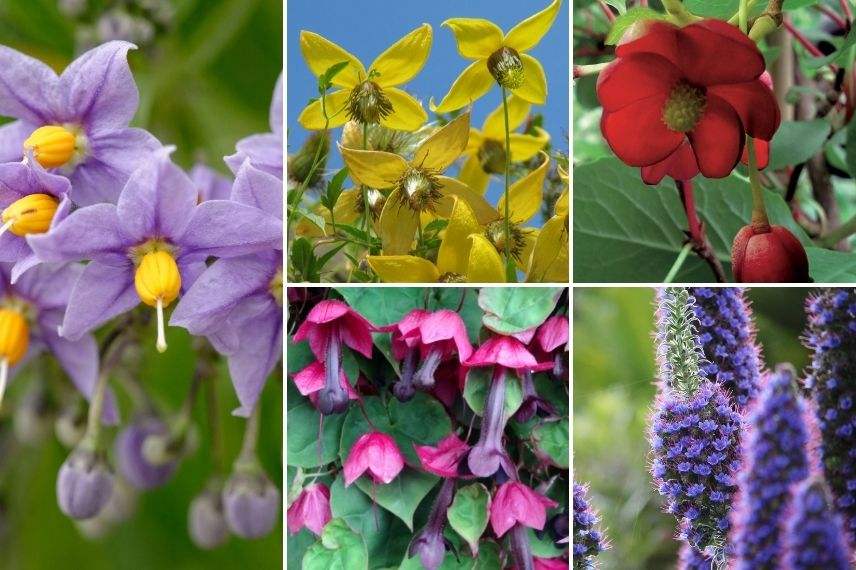
In a pot on a veranda or on a terrace in the south, solanum with violet flowers close to the bluish purple of the giant spikes of Echium. To the right in the centre, the two climbing plants, clematis tangutica with yellow bells and Rhodochiton atrosanguineus with pendulous flowers featuring a black heart. In the top right, the distinguished blood-red flowering of Schisandra rubriflorum.
- Subscribe!
- Contents
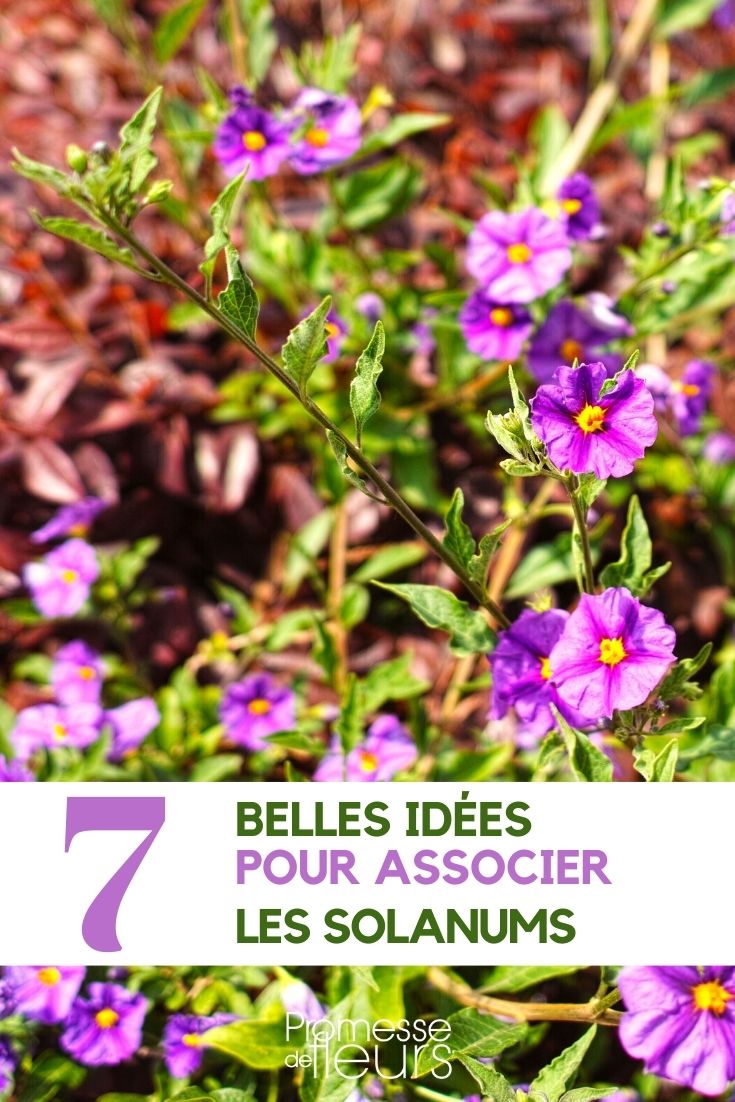































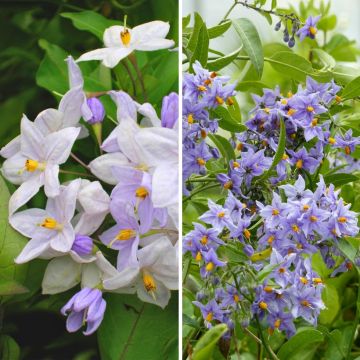
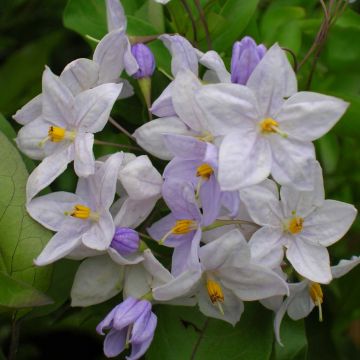

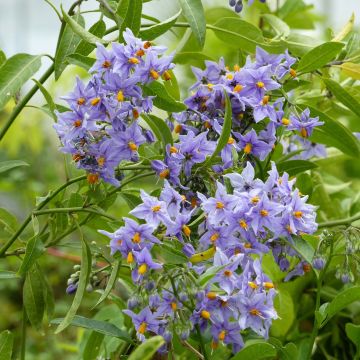

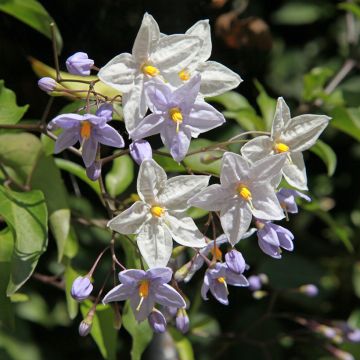
Comments